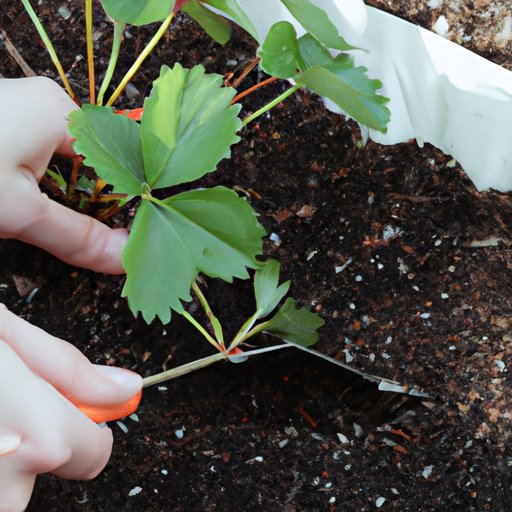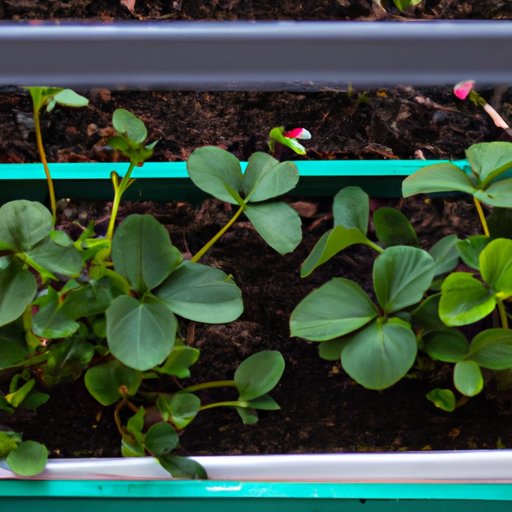
Introduction
Have you ever wondered if it’s possible to grow strawberries from seeds? Well, the answer is yes! Growing strawberries from seeds is not only a fun and rewarding experience but it is also an easy and cost-effective way to start your own small garden. In this article, we will provide you with a step-by-step guide on how to grow strawberries from seeds. We will also cover everything from soil preparation to caring for your plants as they grow.
7 Simple Steps to Grow Strawberries from Seeds
The following 7 steps are all you need to successfully grow strawberries from seeds:
1. Choosing the right seeds:
Before planting, it’s important to select high-quality seeds. You can find these seeds at the local garden center or order them online. Choose seeds that are disease-resistant and suited to your climate. Do not compromise quality for a cheaper seed.
2. Preparing the soil:
Strawberries prefer slightly acidic soil with a pH ranging from 5.5 to 6.5. You can test your soil’s pH level using a simple and inexpensive soil testing kit. Mix compost or manure, peat moss, and sand into the soil. This will improve the soil’s fertility and drainage ability.
3. Planting the seeds:
Plant the seeds at least 1/4-inch deep in the soil, and water it. Then, cover it with a plastic wrap or a greenhouse cover. This will keep the soil moist and warm until the seeds germinate. Germination typically occurs within two weeks.
4. Watering and fertilizing:
For the first two weeks, water the plants gently just to keep the soil moist. Once they start growing, water them regularly. Apply diluted fertilizer with nitrogen and potassium into the soil every 2-3 weeks. Use organic fertilizer if possible, as it releases its nutrients more slowly and will not damage the plant.
5. Providing proper sunlight:
Strawberries need full sun exposure to grow. They should get at least six to eight hours of direct sunlight per day. If your location doesn’t get that much sunlight, use LED grow lights to supplement the daylight hours.
6. Transplanting seedlings:
If you are planning to transplant your strawberry seedlings, start transplanting them once they are about three weeks old. Plant them in nutrient-rich soil and keep them well-watered.
7. Caring for the plants as they grow:
Water regularly and add compost or manure to the soil as needed. Ensure they get enough sunlight. However, if growing in hot temperatures, provide shade if necessary.
Everything You Need to Know About Growing Strawberries from Seeds
Let’s estimate strawberries’ characteristics before planting and how to care for them after planting.
Different types of strawberry seeds
The plant that grows from a strawberry seed will produce a different strawberry from the parent plant as strawberries are hybrids of different varieties. Though a strawberry plant might yield a fruit that is quite different from the parent plant, there are many cultivars of strawberry plants available to choose from: Everbearing, Day-neutral, and June bearing.
Ideal soil conditions and pH levels for growing strawberries from seeds
Strawberries prefer slightly acidic soil with a pH ranging between 5.5 and 6.5. They also like well-draining soil, which allows air and water to move freely throughout the growing medium. Strawberries grow best in sandy or loamy soils with plenty of organic matter.
Pests and diseases that may affect strawberry plants
Strawberries are vulnerable to a range of pests and diseases. Regularly check your plants for infestations of mealybugs, aphids, slugs, or spider mites, as well as evidence of diseases like leaf spot, botrytis, or wilt. To prevent these issues, take preventative measures as soon as possible.
The best time to plant strawberry seeds
You can plant the seeds as soon as the temperatures rise, and the ground has been warmed up. In most places, this will be between late winter and early spring, but in warmer locations, it might be earlier. Avoid harvesting the berries in high humidity or when the ground is wet. The best time to harvest the berries is earlier in the day when it’s still cool, before the sun has a chance to warm the fruit up.
Seed to Fruit: A Guide to Growing Strawberries at Home
The journey from planting the seed to getting the fruit can be broken down into 4 easy steps:
Pre-planting preparations
You first want to find the right location. Make sure there is plenty of sun and protection from the wind. Prepare the potting mix and fertilizer in advance. Starting the strawberry seeds indoors gives them a head start before the ground can be worked in. Ensure to spay the transplant with water often so the soil doesn’t dry out.
Planting and caring for the seeds
Plant the seeds at a depth of about 1/4 inch in starter trays or decorative pots. Ensure to keep the soil moist, but not waterlogged. Install grow lights to keep the seedlings growing strong. Once the seedlings reach about 3 inches tall, harden them off by transplanting them outdoors.
Growth and development of the plants
Strawberry plants grow relatively slowly, but by the end of their first growing season, they will produce their first fruits. Maintain proper soil moisture, pH, and nutrient levels and protect the berries from weather damage or hungry pests. Younger fruits need lower levels of nutrients and larger amounts of water. For mature plants, nutrient levels should be increased to defer this damage and improve plant vigor.
Harvesting the fruit
Harvest your ripe berries by twisting them gently. Remove the outer casing from the berries to allow them to breathe. You can store them in the fridge, but wait until just before use to wash them off so they don’t become waterlogged.

The Complete Process of Growing Strawberries from Seeds
The process of growing strawberries from seeds involves multiple stages each requiring special care.
Different stages of plant growth and development
Strawberries have three stages of growth and development. Germination (0-14/inches), emerging (14-60 inches), and then maturity (60-360 inches). Seedlings develop first and need low lighting, moderate watering, and high temperatures. The vegetative stage requires high lighting, moderate watering, extremely high temperatures, and nitrogen concentration. When the flowers appear, focus on moderate lighting, regular watering, and even temperatures. During fruit development (maturity), it needs moderate lighting and nitrogen and phosphate with low potassium and magnesium.
Requirements for each stage
The requirements differ from stage to stage. In the vegetative stage, the plant requires expansive root growth and challenges from the leaves to protect against pests and disease. In the flowering stage, maintaining a moderate airflow is crucial for nutrient absorption. During the fruiting stage, ensuring proper humidity and temperature is a must.
Tips and advice for addressing problems at each stage
Adjust watering based on the amount of soil around the roots. Overwatering may lead to rot while under-watering can stunt growth. Ensure you have access to adequate light sources to promote growth rates during early growth periods. Furthermore, move your plants to ensure smooth air flow to limit the chances of mold development. In the mature stage, remove mulch materials and lower plant density to improve the harvestability of the strawberries.
Tips and Tricks for Successfully Growing Strawberries from Seeds
Here are some tips and tricks for successfully growing strawberries from seeds:
Proper lighting and watering
Proper lighting and watering are the keys to growing healthy strawberry plants from seeds that result in better berry production.
Maintaining proper soil pH levels
Strawberries need slightly acidic soil with a pH level between 5.5 to 6.5 to thrive. A soil pH testing kit can test your soil for accuracy, and caution is taken to mix compost, peat moss, sand, and lime into your soil.
Preventing pests and diseases
The main strategy for preventing pests and diseases for growing strawberries from seeds is keeping plants healthy. Overcrowding, lack of sunlight, uneven watering, and soil issues can exacerbate pests or diseases. Certain chemicals may damage or stunt growth, and organic solutions such as neem oil, are effective at combating pests and are safe for consumption.
Starting Fresh: Growing Strawberries from Seedlings
Starting with seedlings offers many benefits:
Benefits of starting with seedlings instead of seeds
Starting seeds indoors gives them a head start and allows the seeds to be planted outside earlier in the growing season. They are often less susceptible to pests and disease and will flower and fruit earlier than direct-grain seeds.
Choosing healthy seedlings for your garden
Make sure the seedlings are healthy; they’re neither too small nor too large. They must have a healthy plant structure, and no deformities. Sedentary roots are a sign of healthy plants.
Planting and caring process for seedlings
Transplant the seedlings into fresh soil and gently water them. The soil should be well drained and have added organic matter. It is best to grow seedlings in a large pot first, and then after several weeks, transplant the healthy seedlings into the garden.
From Tiny Seed to Juicy Berry: How to Grow Strawberries
By following these simple guidelines, anyone can grow juicy and delicious strawberries at home.
It doesn’t matter whether you are planting indoors or outdoors, the bottom line is strawberries are easy to grow. From seed to fruit, there is a lot to learn about the process of growing strawberries from seeds, but with patience, care, and attention to detail, anyone can do it.
Conclusion
Growing strawberries from seeds is a simple, fun, and rewarding activity that adds fresh fruits and vegetables to your diet and is a great way to start your small garden. By following the guidelines provided in this article, you will be able to grow your own strawberries from seeds successfully.




